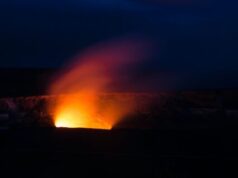Digital reconstruction of the Canadian Arctic fossil bear, Protarctos abstrusus.
Credit: Xiaoming Wang
Researchers from the Canadian Museum of Nature and the Natural History Museum of Los Angeles County have identified remains of a 3.5-million-year-old bear from a fossil-rich site in Canada’s High Arctic. Their study shows not only that the animal is a close relative of the ancestor of modern bears — tracing its ancestry to extinct bears of similar age from East Asia — but that it also had a sweet tooth, as determined by cavities in the teeth.
The scientists identify the bear as Protarctos abstrusus, which was previously only known from a tooth found in Idaho. Showing its transitional nature, the animal was slightly smaller than a modern black bear, with a flatter head and a combination of primitive and advanced dental characters. The results are published today in the journal Scientific Reports.
“This is evidence of the most northerly record for primitive bears, and provides an idea of what the ancestor of modern bears may have looked like,” says Dr. Xiaoming Wang, lead author of the study and Head of Vertebrate Paleontology at the Natural History Museum of Los Angeles County (NHMLA). “Just as interesting is the presence of dental caries, showing that oral infections have a long evolutionary history in the animals, which can tell us about their sugary diet, presumably from berries. This is the first and earliest documented occurrence of high-calorie diet in basal bears, likely related to fat storage in preparation for the harsh Arctic winters.”
The research team, which included co-author Dr. Natalia Rybczynski, a Research Associate and paleontologist with the Canadian Museum of Nature, were able to study recovered bones from the skull, jaws and teeth, as well as parts of the skeleton from two individuals.
Find your dream job in the space industry. Check our Space Job Board »
The bones were discovered over a 20-year period by Canadian Museum of Nature scientists, including Dr. Rybczynski, at a fossil locality on Ellesmere Island known as the Beaver Pond site. The peat deposits include fossilized plants indicative of a boreal-type wetland forest, and have yielded other fossils, including fish, beaver, small carnivores, deerlets, and a three-toed horse.
The findings show that the Ellesmere Protarctos lived in a northern boreal-type forest habitat, where there would have been 24-hour darkness in winter, as well as about six months of ice and snow.
“It is a significant find, in part because all other ancient fossil ursine bears, and even some modern bear species like the sloth bear and sun bear, are associated with lower-latitude, milder habitats,” says co-author Dr. Rybczynski. “So, the Ellesmere bear is important because it suggests that the capacity to exploit the harshest, most northern forests on the planet is not an innovation of modern grizzlies and black bears, but may have characterized the ursine lineage from its beginning.”
Dr. Wang analyzed characteristics of fossil bear remains from around the world to identify the Ellesmere remains as Protarctos and to establish its evolutionary lineage in relation to other bears. Modern bears are wide-ranging, found from equatorial to polar regions. Their ancestors, mainly found in Eurasia, date to about 5 million years ago.
Fossil records of ursine bears (all living bears plus their ancestors, except the giant panda, which is an early offshoot) are poor and their early evolution controversial. The new fossil represents one of the early immigrations from Asia to North America but it is probably not a direct ancestor to the modern American black bear.
Of further significance is that the teeth of both Protarctos individuals show signs of well-developed dental cavities, which were identified following CT scans by Stuart White, a retired professor with the UCLA School of Dentistry. The cavities underline that these ancient bears consumed large amounts of sugary foods such as berries. Indeed, berry plants are found preserved in the same Ellesmere deposits as the bear remains.
“We know that modern bears consume sugary fruits in the fall to promote fat accumulation that allows for winter survival via hibernation. The dental cavities in Protarctos suggest that consumption of sugar-rich foods like berries, in preparation for winter hibernation, developed early in the evolution of bears as a survival strategy,” explains Rybczynski.
Story Source:Materials provided by Uppsala University.Note: Content may be edited for style and length.
Journal Reference:
Xiaoming Wang, Natalia Rybczynski, C. Richard Harington, Stuart C. White, Richard H. Tedford.A basal ursine bear (Protarctos abstrusus) from the Pliocene High Arctic reveals Eurasian affinities and a diet rich in fermentable sugars. Scientific Reports, 2017; 7 (1) DOI:10.1038/s41598-017-17657-8











